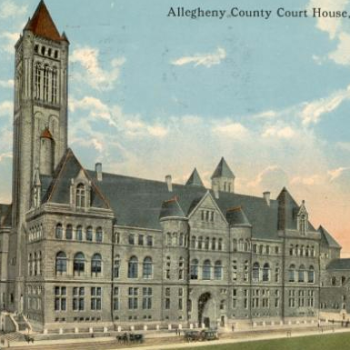In the spring of 2015, I began a project to identify and analyze all the death sentences that have been imposed in the history of Allegheny County. After careful review of Allegheny County prosecution, jail, and coroner records; state appellate, pardon, and prison records; the entire published record of Pittsburgh newspapers; birth, death, and other genealogical sources; and vast secondary sources, that effort is now complete.
My research has identified 201 civilian death sentences, the first of which was imposed on Mamachtaga (or Mamachtaguin), a Lenape Indian who had killed two white settlers, in 1785. As of this writing (November 2020), the most recent death sentence was imposed on Richard Poplawski in 2011, for the 2009 ambush murder of three police officers. In thirteen other cases, a defendant was convicted of capital murder but was never formally sentenced to death, whether due to acquittal on retrial or death before sentencing.
Additional death sentences may yet be imposed in Allegheny County, though with a state execution moratorium in place since February 13, 2015, and a broader national reconsideration of the death penalty ongoing, few such sentences are likely. Pennsylvania’s most recent execution was in 1999. The last Allegheny County execution was way back in 1959. I do not expect any additional executions.
 In addition to these cases, which are the primary focus of my research, two federal death sentences were imposed in Allegheny County as a result of the Whiskey Rebellion in the 1790s. Both defendants were subsequently pardoned. During the same era, seventeen soldiers garrisoned in Pittsburgh were sentenced to death by military authorities for desertion; fourteen of those soldiers were executed. There were also twelve cases in which a capital conviction was gained but, for a variety of reasons, a death sentence was not imposed. All of these cases are detailed herein.
In addition to these cases, which are the primary focus of my research, two federal death sentences were imposed in Allegheny County as a result of the Whiskey Rebellion in the 1790s. Both defendants were subsequently pardoned. During the same era, seventeen soldiers garrisoned in Pittsburgh were sentenced to death by military authorities for desertion; fourteen of those soldiers were executed. There were also twelve cases in which a capital conviction was gained but, for a variety of reasons, a death sentence was not imposed. All of these cases are detailed herein.
Of those 201 civilian death sentences, 102 resulted in an execution. In most of the rest of the cases, the original death sentence was overturned by judicial or gubernatorial action. A few others escaped from death row; most famously, the Biddle boys, who were killed soon after; others were never apprehended. Also, as of this writing, nine Allegheny County inmates remain on Pennsylvania’s death row.
The Death Penalty as a Peculiar History
In the process of identifying and analyzing these cases, I came to recognize them as a powerful, though certainly peculiar and even perverse, lens through which to see the history of Pittsburgh: its settlement; its industrial growth and decline; its labor and racial unrest; and its migrant, and immigrant movements. In telling the stories of these cases, I have sought also to tell that history; to place each case in the context of the time and place and tensions in which it occurred. In that way, I hope, each case may be read as a chapter in a much larger book. As much as possible, I have provided links to maps, photos, and written and audio/video resources, to tell these stories and suggest their larger significance.
As my work continues, I will be turning my attention to the more sociological questions raised by these cases: analyzing the ways in which offender and victim race, class, and gender and changing patterns of industrialization, urbanization, immigration, and labor/management relations, have shaped the use of the death penalty in Allegheny County.








